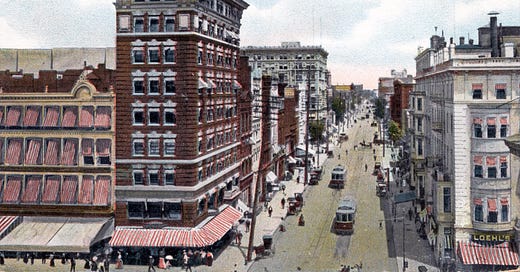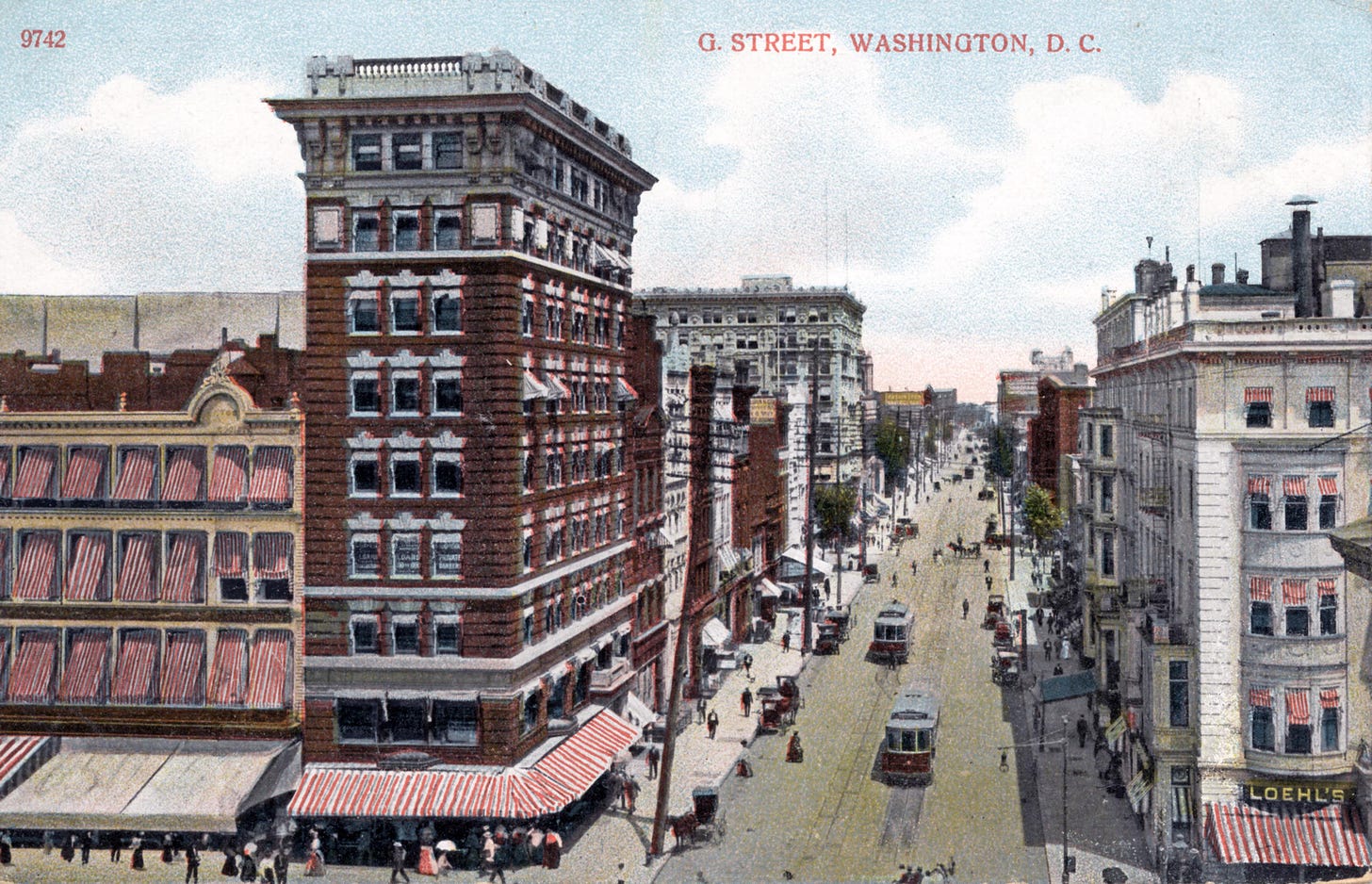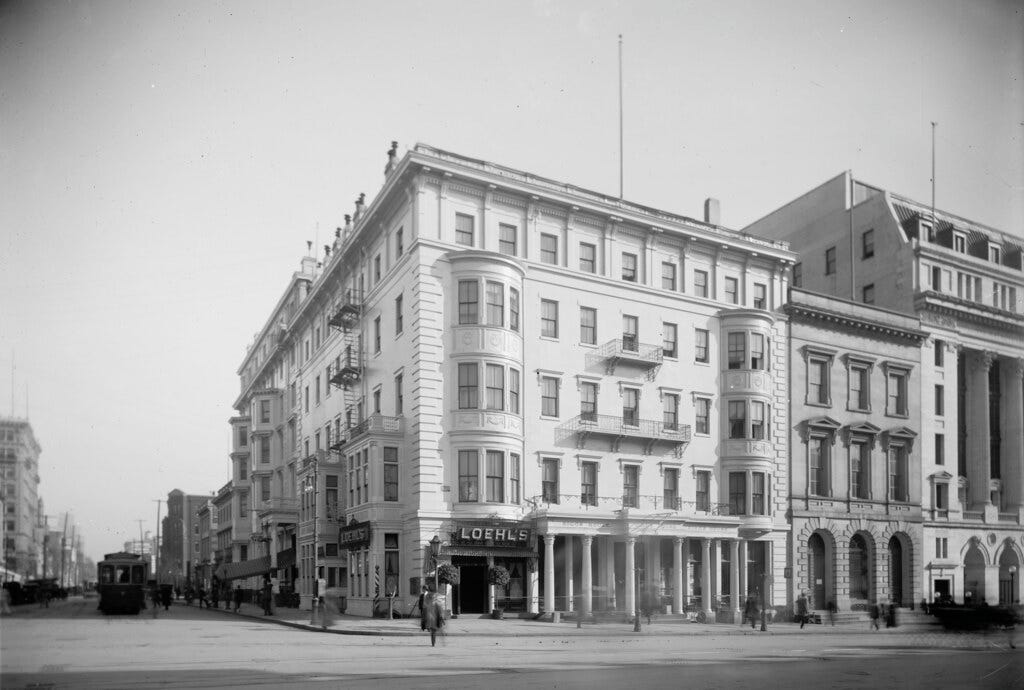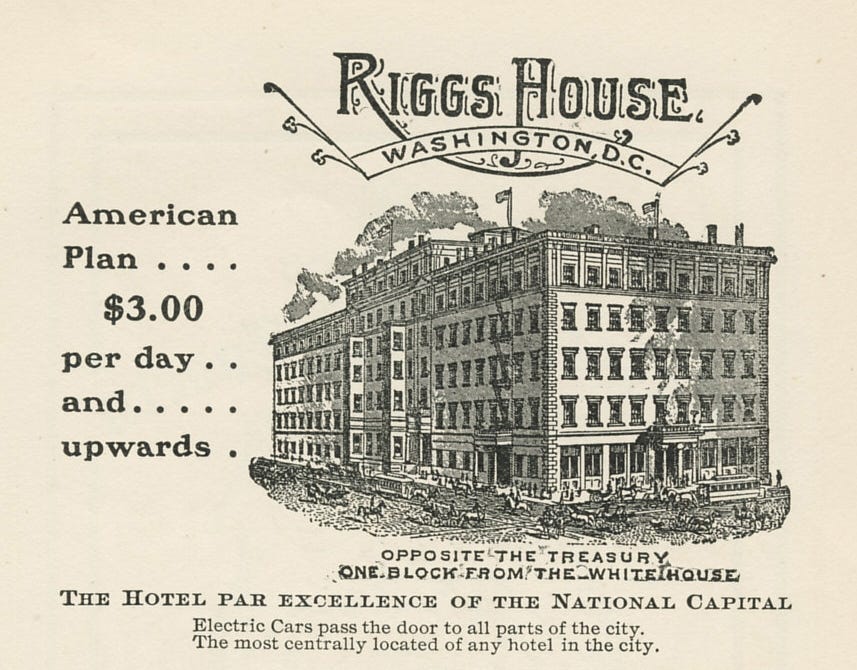The Riggs House at 15th and G Streets NW
Here's a postcard view of G Street NW in the early 1900s, as seen facing east from the Treasury Department. This view is a block north of the previously discussed scene at 15th and F in Washington's then-booming financial district, where much construction was taking place. The tall red building in this view, on the northeast corner of 15th and G, is the Home Life Building, built in 1901. The Washington Building took its place in 1927 and remains there today.
We're focusing today on the white building on the southeast corner, glimpsed to the right. This is a hotel called the Riggs House that was a prominent D.C. landmark in the last half of the 19th century.
The building was originally constructed between 1859 and 1860 by banker George W. Riggs (1813-1881), with the intention that it be leased as a hotel. However, the first tenant instead was the federal government, which signed a ten-year lease for the building at a cost of $18,000 annually. Beginning in 1861, it served as the first home of the Internal Revenue Bureau, which moved some five years later into the Treasury Department building. The Army Quartermaster General's office occupied the structure for the remainder of the government's lease.
After the government vacated the building, it may have sat idle for awhile but was rebuilt and finally opened for its original purpose, as a hotel, in 1876. The new Riggs House quickly gained a reputation for both elegant accommodations and excellent cuisine under the leadership of Caleb W. Spofford, who was a friend of Riggs and had previously managed the prestigious Hotel Continental in Philadelphia. Spofford and his wife were ardent supporters of women's suffrage, and as a result key figures such as Susan B. Anthony, Phoebe Couzins, and Elizabeth Cady Stanton chose to stay at the hotel.
The Riggs House in the 1870s and 1880s became a hotel for politicians, especially those from New England and the Northeast. The hotel billed itself as the "home of statesmen and rendezvous of bons vivants." Presidents Garfield and Harrison were frequent visitors. Garfield regularly strolled over from the White House to play billiards with members of his administration. Harrison stayed at the hotel for six seasons when he was a senator from Indiana.
The hotel prospered and an addition was built in the rear to accommodate increased patronage. Unfortunately, however, Spofford was not as good at bookkeeping as he was at hospitality, and despite many years of success, he began to run up debts that became insurmountable. In May 1891, after Spofford once again failed to pay his monthly rent, the Riggs heirs seized the hotel and auctioned off its furniture to cover the costs of the overdue rent. This left a fairly clean slate for Col. Orrin G. Staples, already proprietor of the Willard Hotel, to step in and take over.
Staples undertook a thorough renovation before reopening the hotel in October 1891. A Washington Post reporter, given a preview of the remodeled hostelry, had this to say about it: "Cherry, mahogany, rosewood, and beveled plate glass are conspicuous upon entering" the hotel's new saloon. "Crystal and silverware are prominent everywhere. Passing along the corridor toward the eastern extremity of the house, the large reception-room is first encountered. One sees here two immense mirrors extending from the floor to the ceiling and said to be the largest in the world. Luxurious upholstered lounges and chairs adorn this apartment, and a magnificent velvet carpet deadens every foot fall and gives an air of comfort and seclusion to the room..."
"Fronting Fifteenth Street in the corner of the lobby is the livery stand of Earnest Burgdorf. Here can be procured at all hours of the day or night some of the finest turnouts [coaches and horses] to be found in the city, for Mr. Burgdorf is a connoisseur in horse flesh and all pertaining to it...
"There are accommodations for 500 guests in the sleeping apartments.... Beds...have upon them mattresses of the best South American hair. Black walnut and antique oak furniture of the latest design and pattern rest upon carpets of maquette, Wilton, and Axminster, and in each room is a splendid wardrobe or capacious closet...
"There are also seventy-five private bathrooms for the convenience of guests. It is proposed to fit up in the hotel the finest Turkish, Russian, and electric baths in Washington. This room will be kept open to fill a long-felt want in the city...."
Rates in 1892 were from $3 to $4 per night, on the American plan (meaning meals were included). Staples was a shrewd businessman and made sure that the hotel lived up to expectations for luxury and convenience that guests, then as now, demanded. After his first ten-year lease was up in 1901, Staples again had a thorough renovation undertaken to keep the hotel up-to-date.
When Staples' second ten-year lease was up in 1911, it was not renewed, and Staples was forced to vacate. The owners, Riggs' heirs, decided to tear down the old hotel and replace it with a large office building that could bring in greater profits. The new Riggs Building was constructed on the Riggs House site in 1912. Only the facade of that building remains today, sheathing one end of the Metropolitan Square office building, completed in 1986. We'll discuss that building in our next post.






